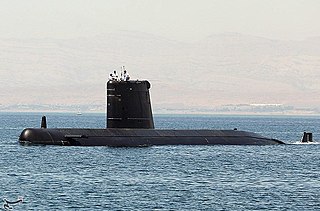
The Agosta-class submarine is a class of diesel-electric attack submarine developed and constructed by the French DCNS in the 1970s to succeed the Daphné-class submarines. The submarines have served in the French Navy as well as exported to the navies of Spain and Pakistan. It also used by Royal Malaysian Navy for the training purpose. They were replaced in French service by the Rubis-class nuclear attack submarines but are still in active service with the navies of Spain and Pakistan. The French Navy grouped this model of submarine in their most capable class as an océanique, meaning "ocean-going."

The Pakistan Navy (PN) is the uniform naval warfare branch of the Pakistan Armed Forces. The President of Pakistan is the Supreme Commander of the Navy. The Chief of the Naval Staff, a four-star admiral commands the navy. The Pakistan Navy operates on the coastline of Pakistan in the Arabian Sea and Gulf of Oman. It was established in August 1947, following the independence of Pakistan from the United Kingdom.

PNS Tariq (DDG-181) was the lead ship of the Tariq-class destroyers in the Surface Command of the Pakistan Navy that served in the military service from 1993 until 2023. Prior to being commissioned in the Pakistan Navy, she served in the Royal Navy, as general purpose frigate HMS Ambuscade.
The Defence Industry of Pakistan, established in September 1951, mainly falls under the purview of the Ministry of Defence Production (MoDP). It aims to foster collaboration and oversee the diverse range of military production facilities that have emerged since Pakistan's independence. The MoDP comprises specialized organizations, each dedicated to various aspects of the defence industry, including research and development, production, and administration.

The Zulfiquar-class frigate, also known as F-22P or in English: Sword class, is a class of multi-mission guided missile frigates, in service with the Pakistan Navy. The class is based on an updated model of the Chinese design, the Type 053H3. The frigates were designed and built jointly in Hudong–Zhonghua Shipbuilding in China and the KS&EW Ltd. in Pakistan.

The Karachi Shipyard & Engineering Works Limited is a major defence contractor and shipbuilding company situated in the West Wharf in Karachi, Sindh in Pakistan.
Admiral Abdul Aziz MirzaNI(M) HI(M) SI(M) SBt LoM LoH was a Pakistan Navy officer who served as the Chief of Naval Staff from 1999 until retiring in 2002, amid taking over the command of the Navy after the revolt and resignation Admiral Fasih Bokhari over the appointment of Chairman joint chiefs.

PNS/M Hashmat (S-135) is the lead ship of Hashmat-class diesel-electric submarine based on the French Agosta-70-class design.
Admiral Saeed Mohammad KhanNI(M) HI(M) SI(M) SBt LoM, was a Pakistan Navy officer who served as the Chief of Naval Staff (CNS) of the Pakistan Navy from 9 November 1991 until retiring from his military service on 9 November 1994. After his retirement, he briefly served as the Pakistan Ambassador to the Netherlands, having been appointed by Prime Minister Benazir Bhutto in the 1990s.
PNS/M Khalid (S-137), is a diesel-electric fast-attack submarine equipped with an air–independent propulsion system and the lead ship of her class active since her commissioning in the Navy in 1999.

PNS/M Hamza (S-139) is a fast-attack submarine powered with an air-independent propulsion system and the third submarine of her Agosta 90B/Khalid-class submarine. She was designed and constructed by the KSEW Ltd. under the technology transfer agreement with France in 1994.

The Karachi affair, otherwise known as Agosta Submarine scandal, was a major military scandal that took place in the second administration of Prime Minister Benazir Bhutto, involving the presidencies of François Mitterrand and Jacques Chirac in 1992–97.

INS Kalvari (S21) is the first of the six indigenous Scorpène-class submarines currently in service with the Indian Navy. It is a diesel-electric attack submarine which is designed by DCNS and was manufactured at Mazagon Dock Limited in Mumbai.
Abaidullah Khan, known as A. U. Khan, HI(m), SBt, SJ, was a three-star rank admiral in the Pakistan Navy, and later a bureaucrat who played a crucial role in procuring and technology transfer of the air-independent propulsion-based Agosta 90Bravo class submarine from France in 1994–1997.

PNS Khaibar (DDG-183) is the Tariq-class destroyer currently in active duty in the Surface Command of the Pakistan Navy since 1994.

PNS Badr (D-184) was the Tariq-class destroyer that served in the Surface Command of the Pakistan Navy from 1994 until being decommissioned from the service in 2014.

PNS Shah Jahan (DDG-186) was a Tariq-class destroyer in service with the Pakistan Navy since being recommissioned in 1994. Based on the British design, Type 21 frigate, she previously served in the Royal Navy as HMS Active as a general purpose frigate.
STM is a defence company in Turkey, operating in the civil, public and private sectors. STM produces various products and services in the fields of air, naval and land defense, as well as software and cyberspace.
The Hangor-class submarines are a class of diesel–electric attack submarines currently being manufactured by a joint-partnership of the China Shipbuilding Industry Corporation (CSIC) and the Karachi Shipyard & Engineering Works (KSEW) for the Pakistan Navy (PN). Eponymously christened after the former-Daphné-class submarines that the PN operated between 1970 and 2006, the class is an export derivative of the Chinese-origin Type 039A/041 attack submarine, currently operated by the People's Liberation Army Navy (PLAN). First unveiled to the public in 2018, the future submarines are envisaged to undertake anti-access/area denial operations within Pakistan's exclusive economic zone, through the use of heavyweight torpedoes and anti-ship cruising missiles.











